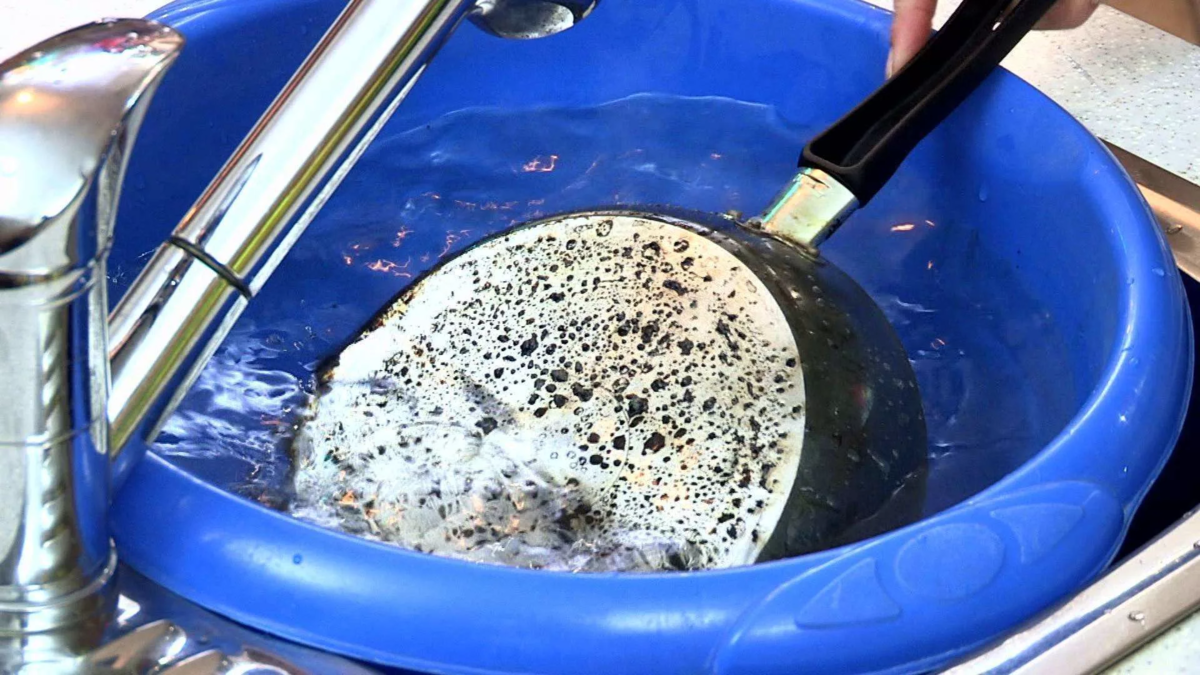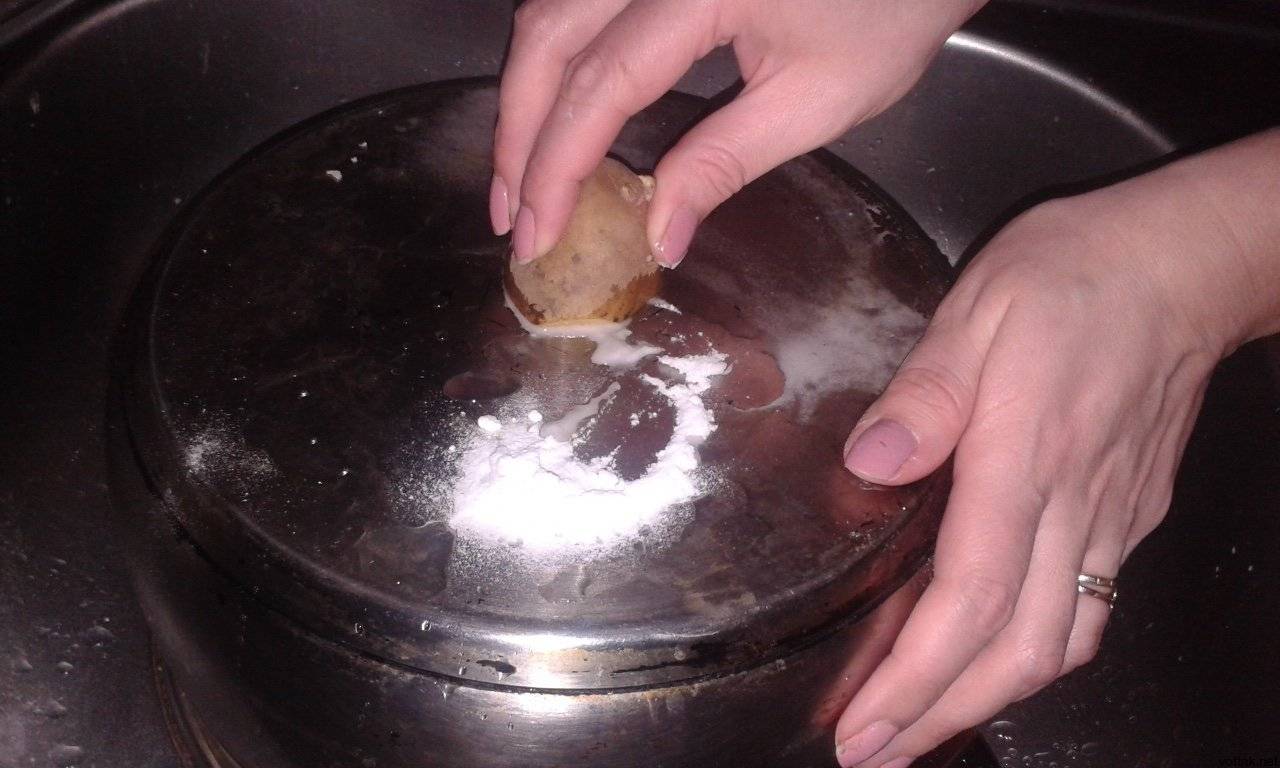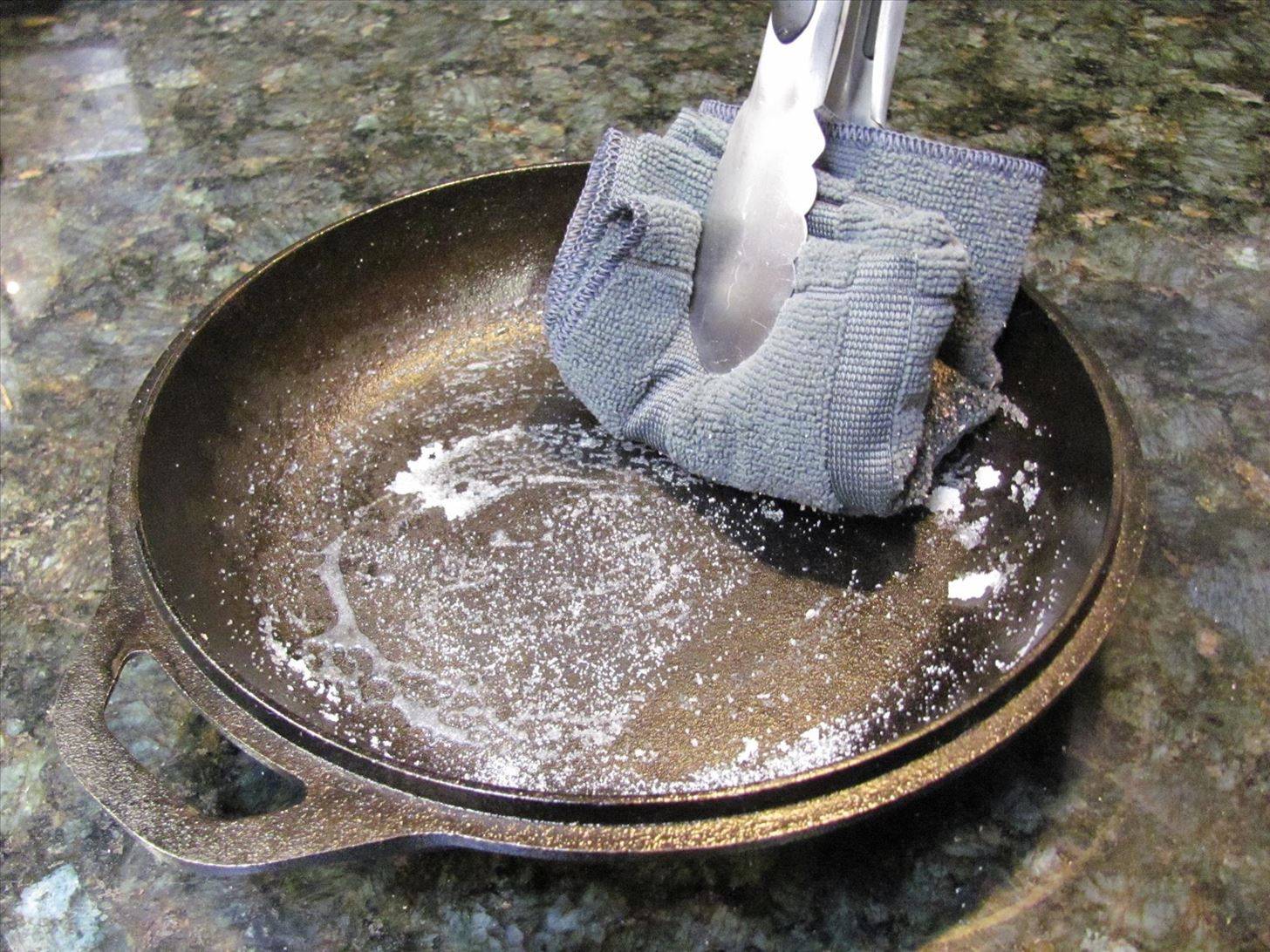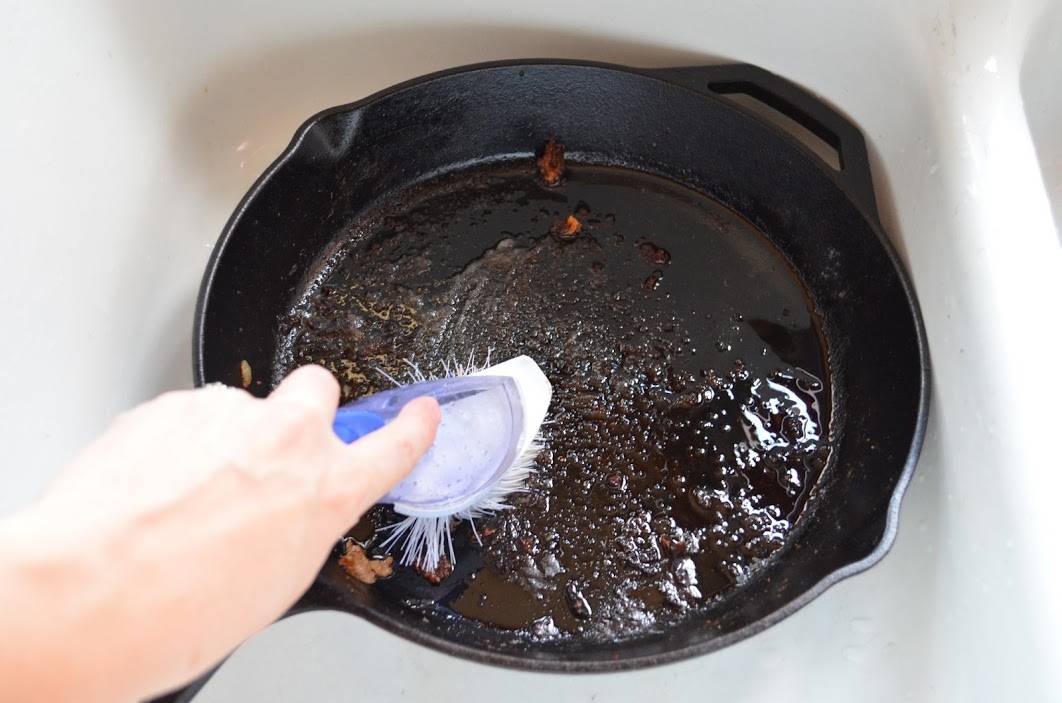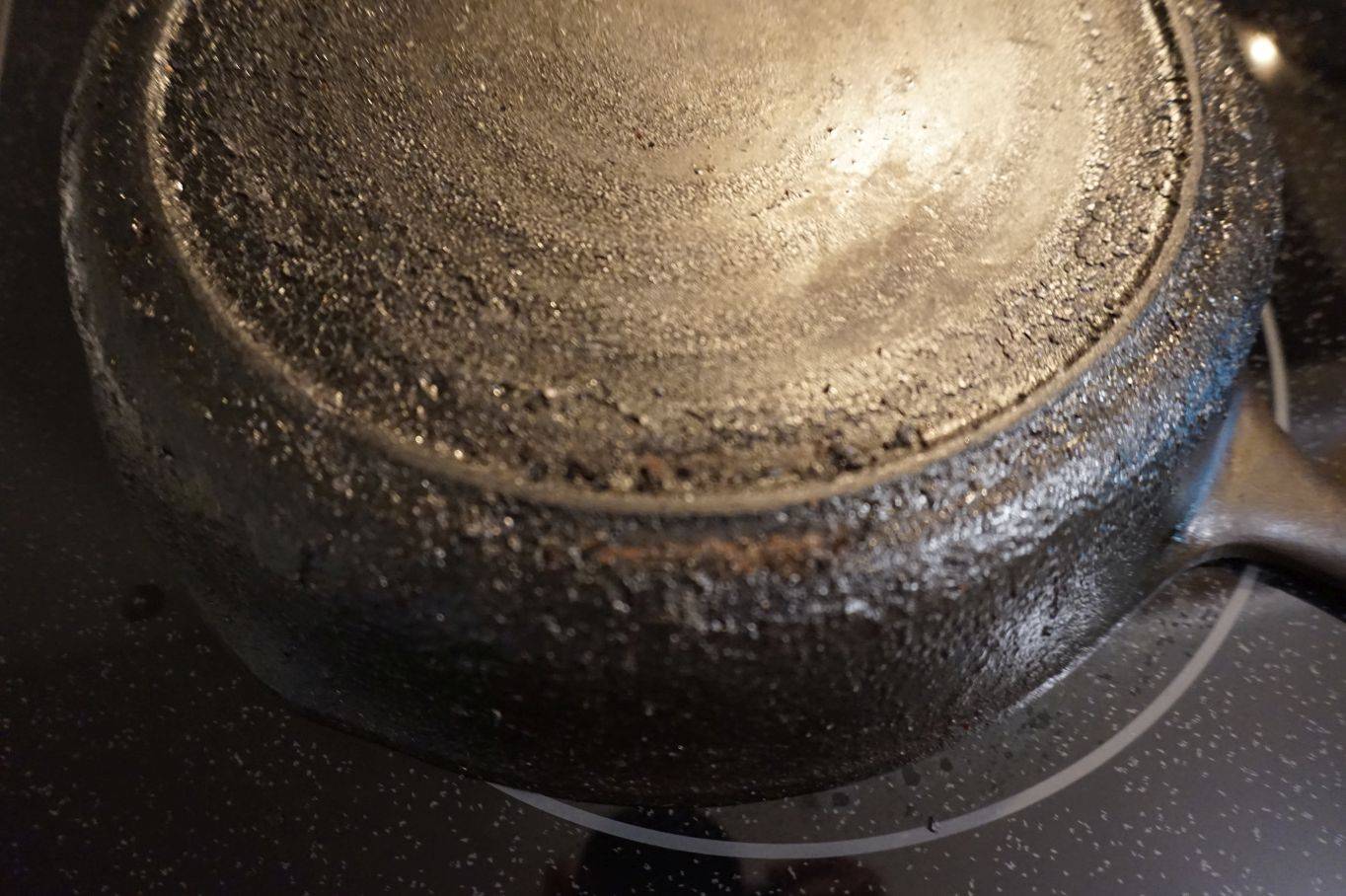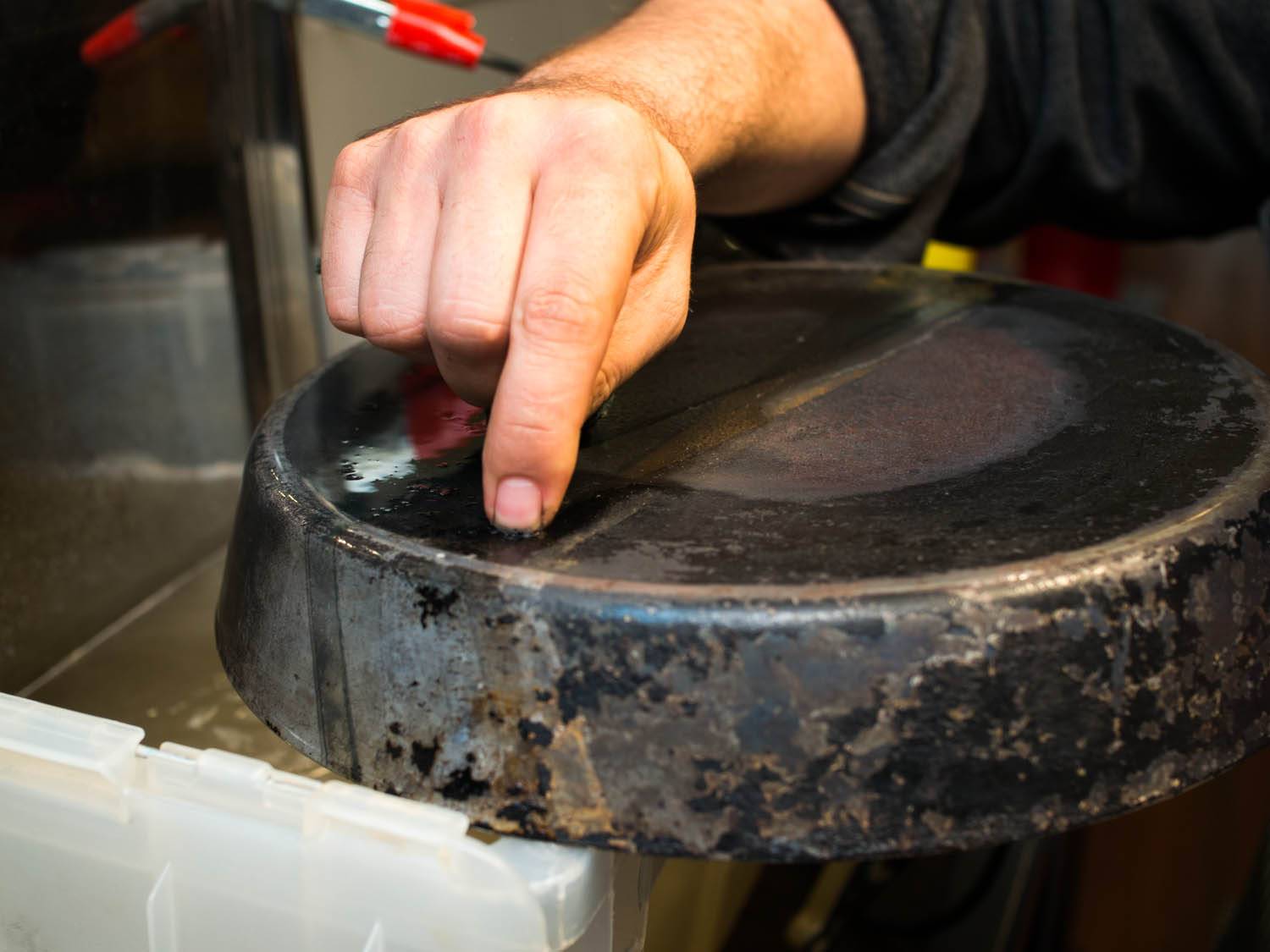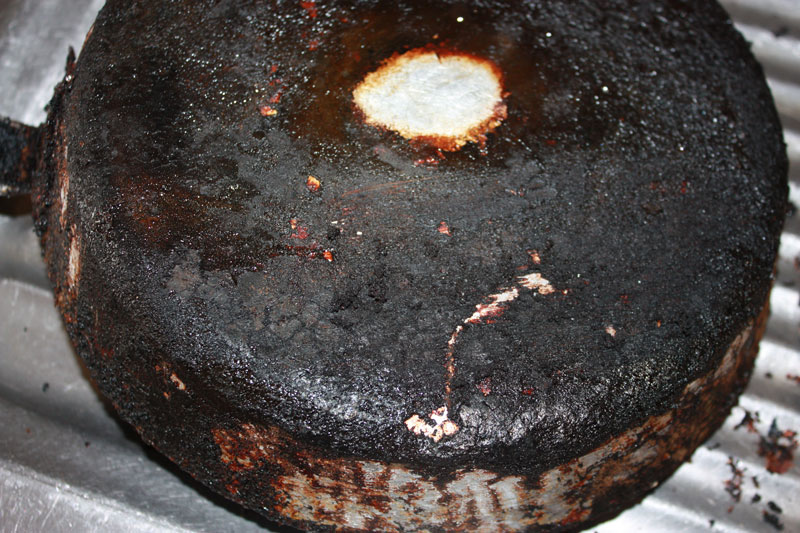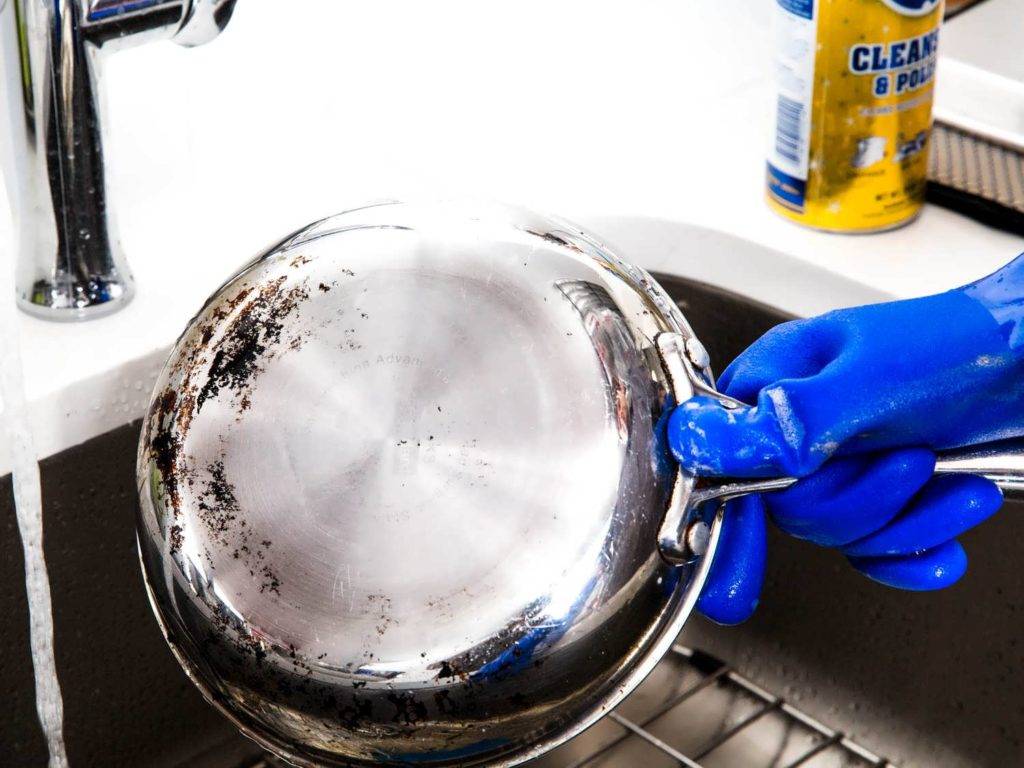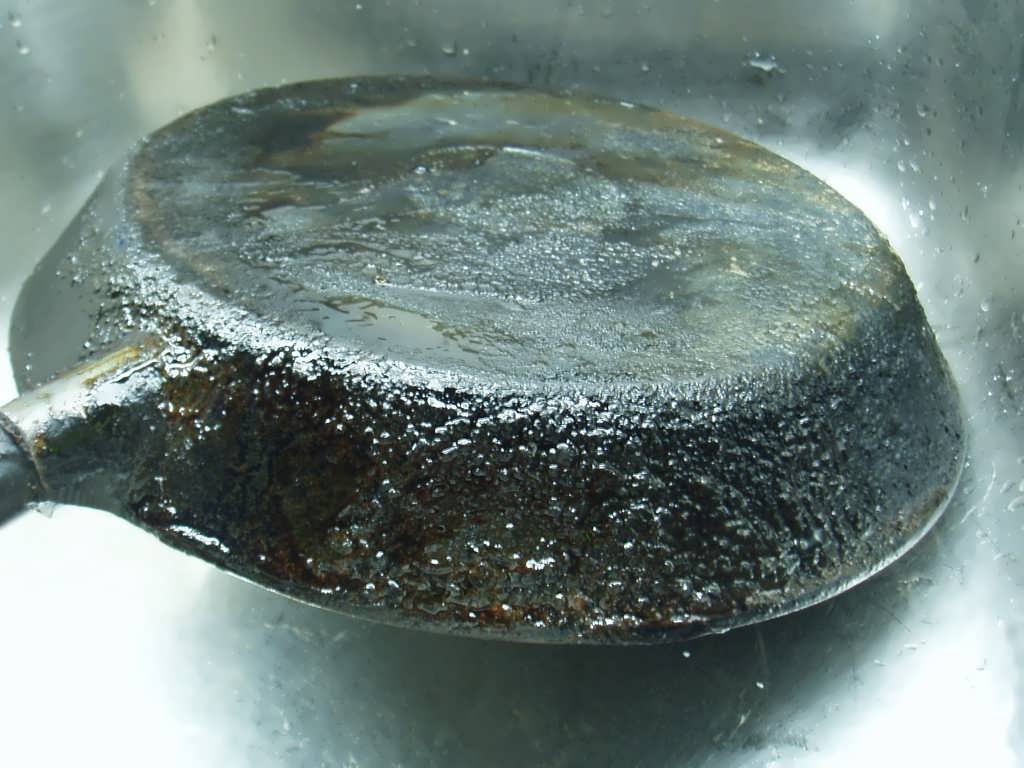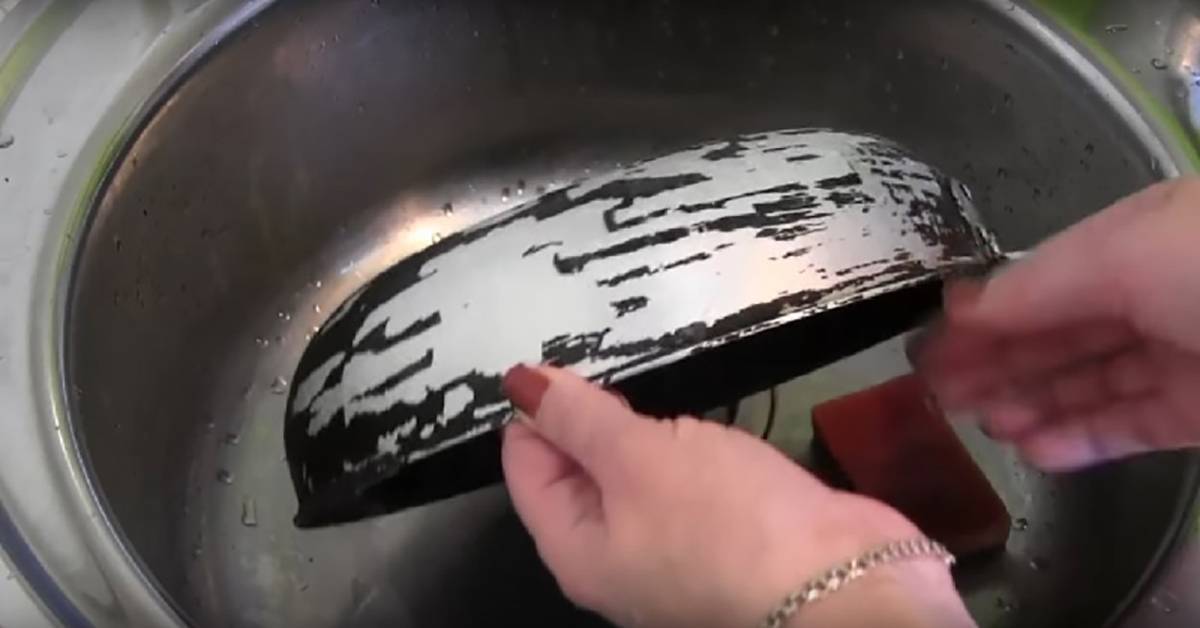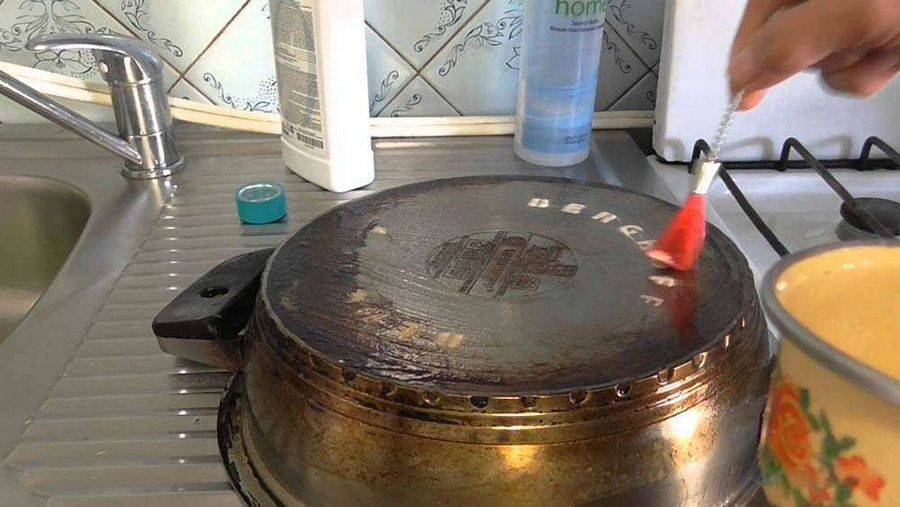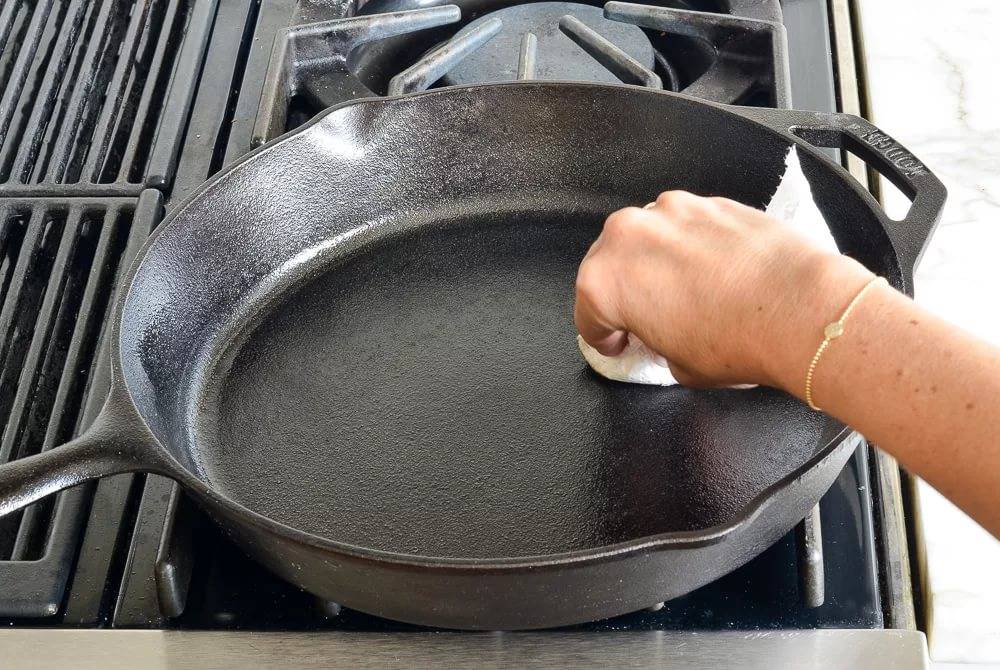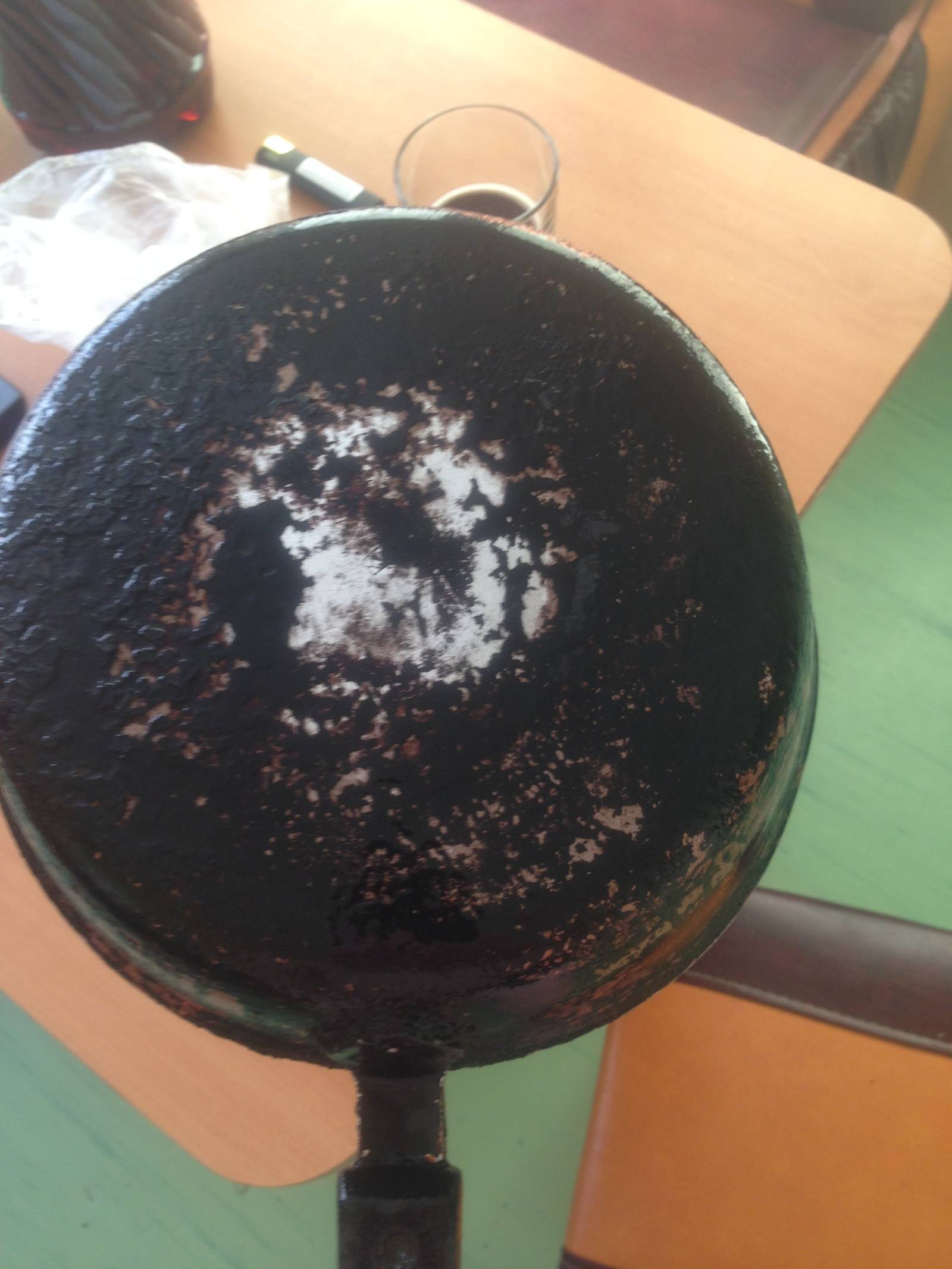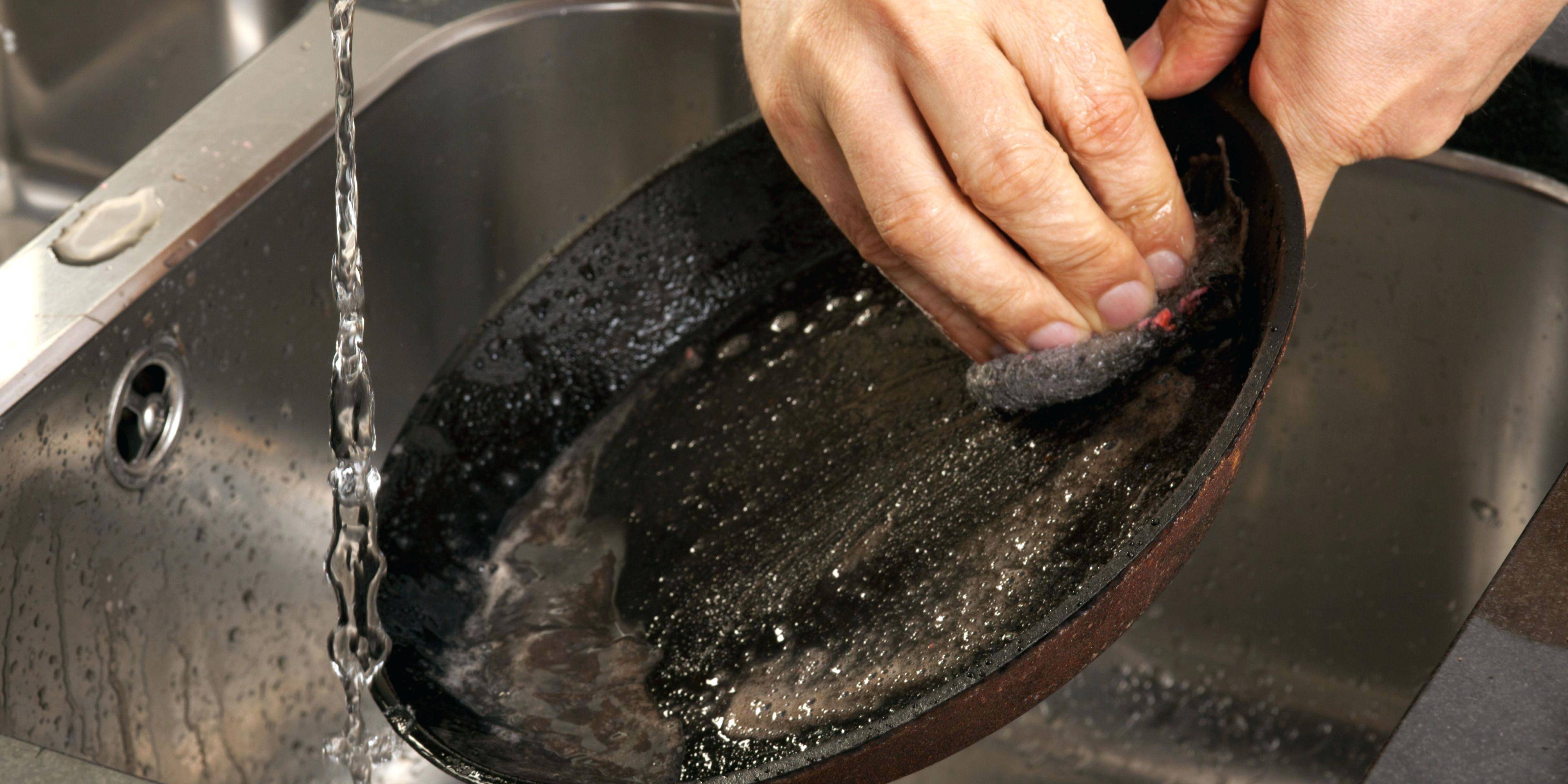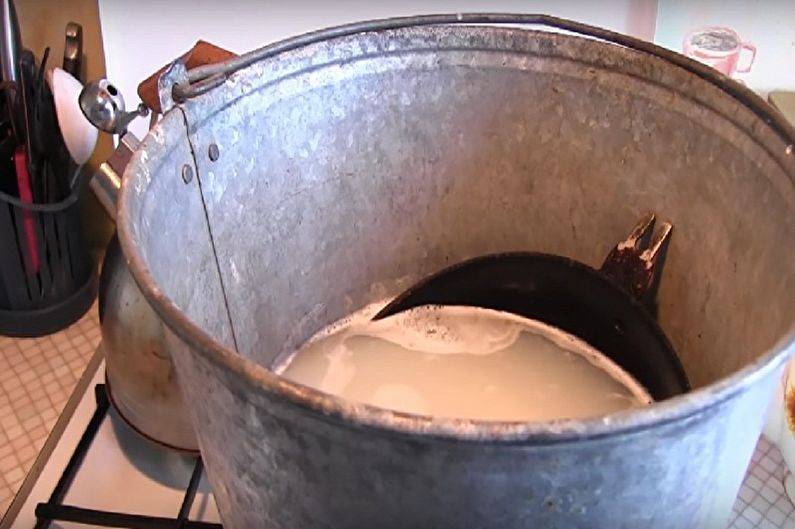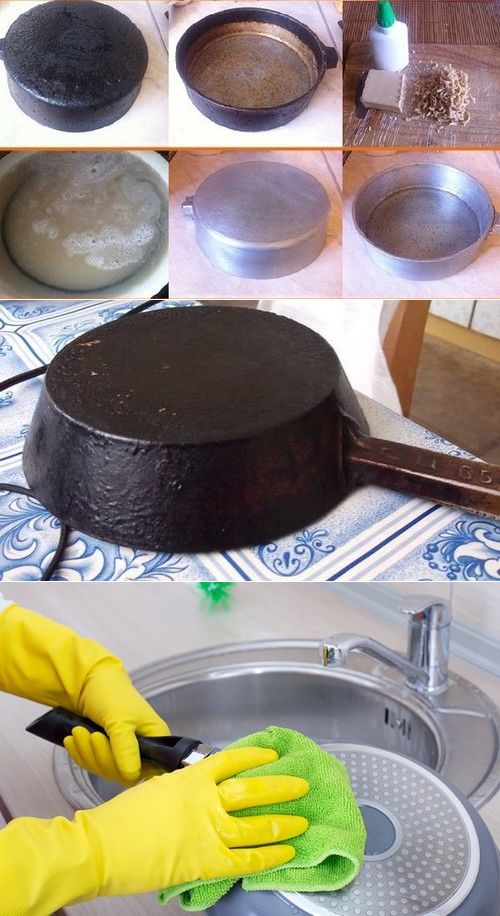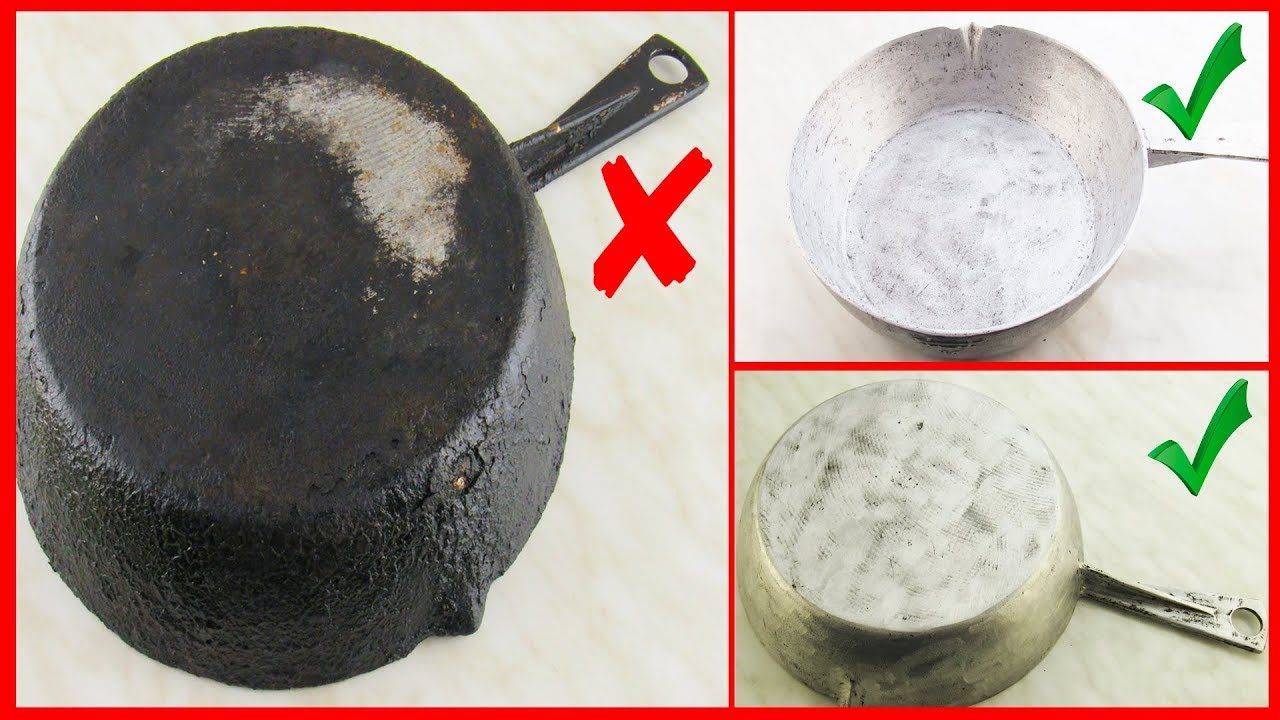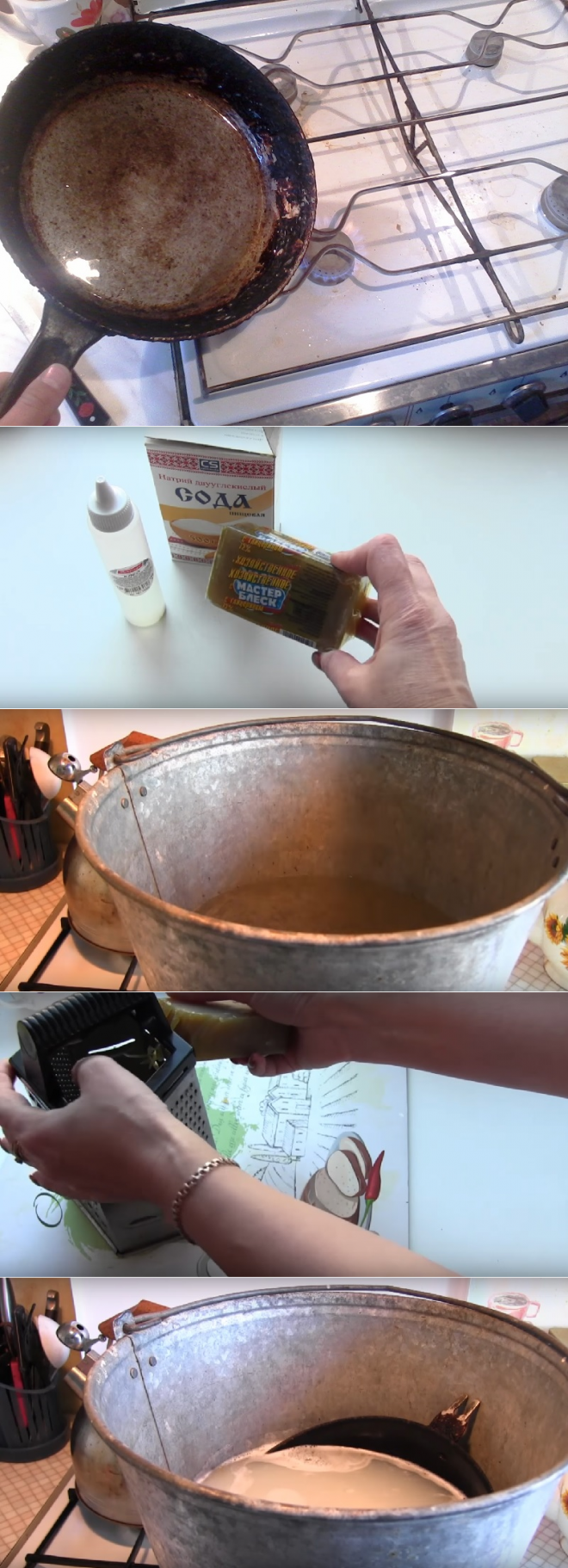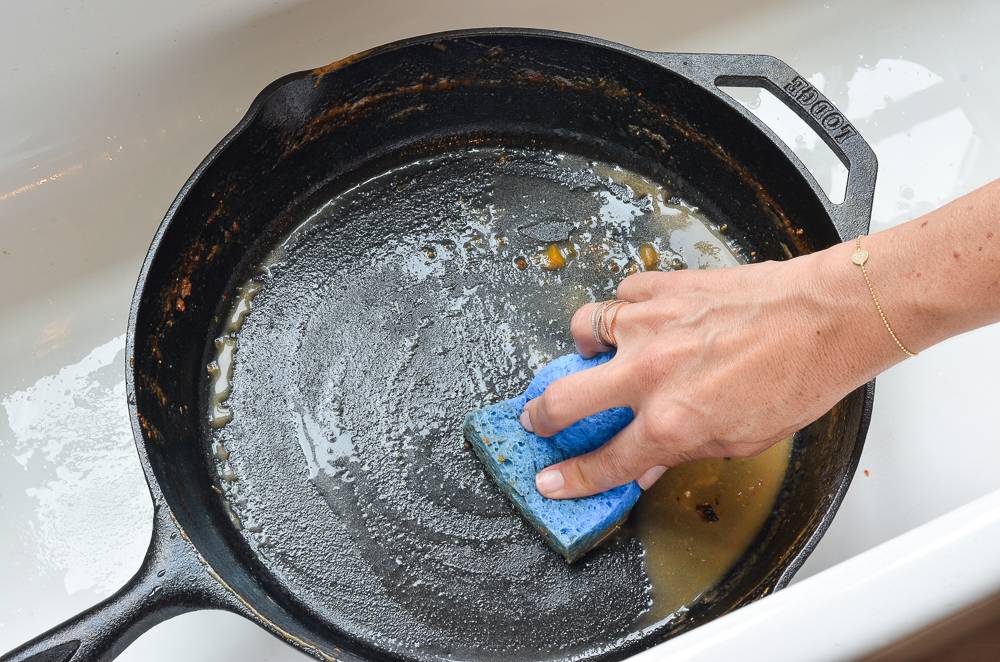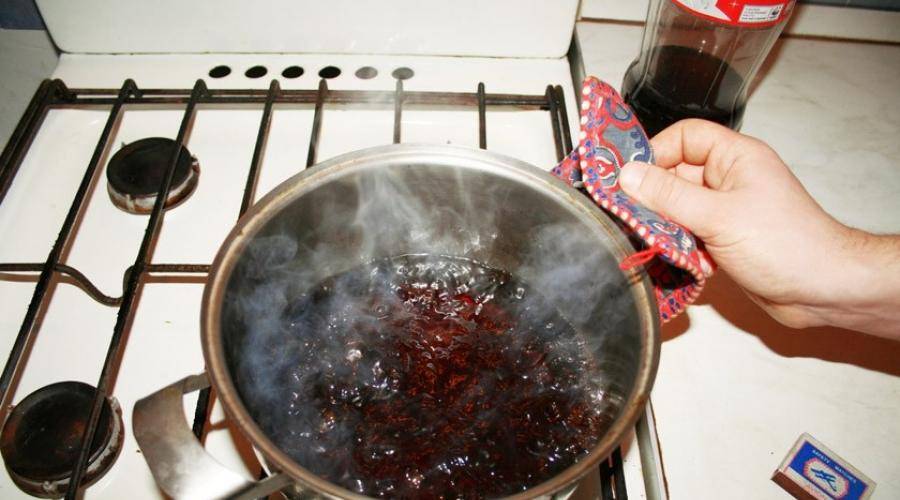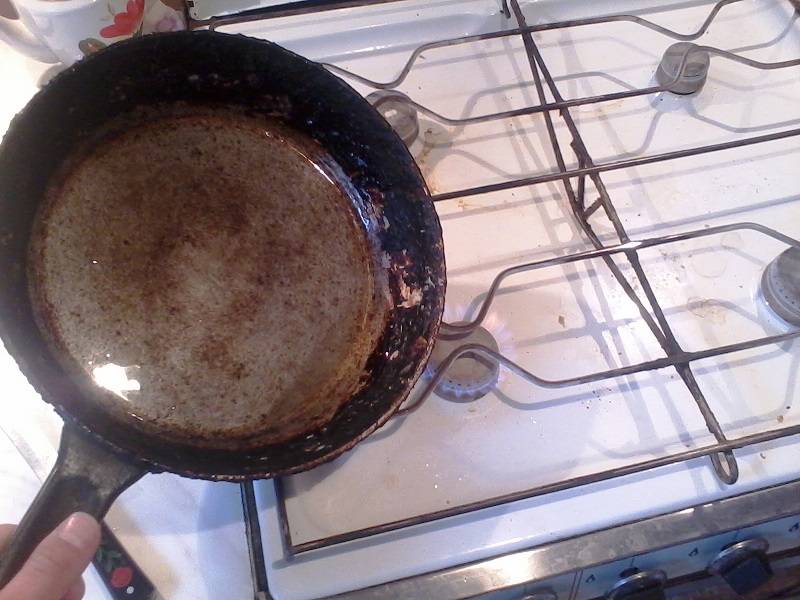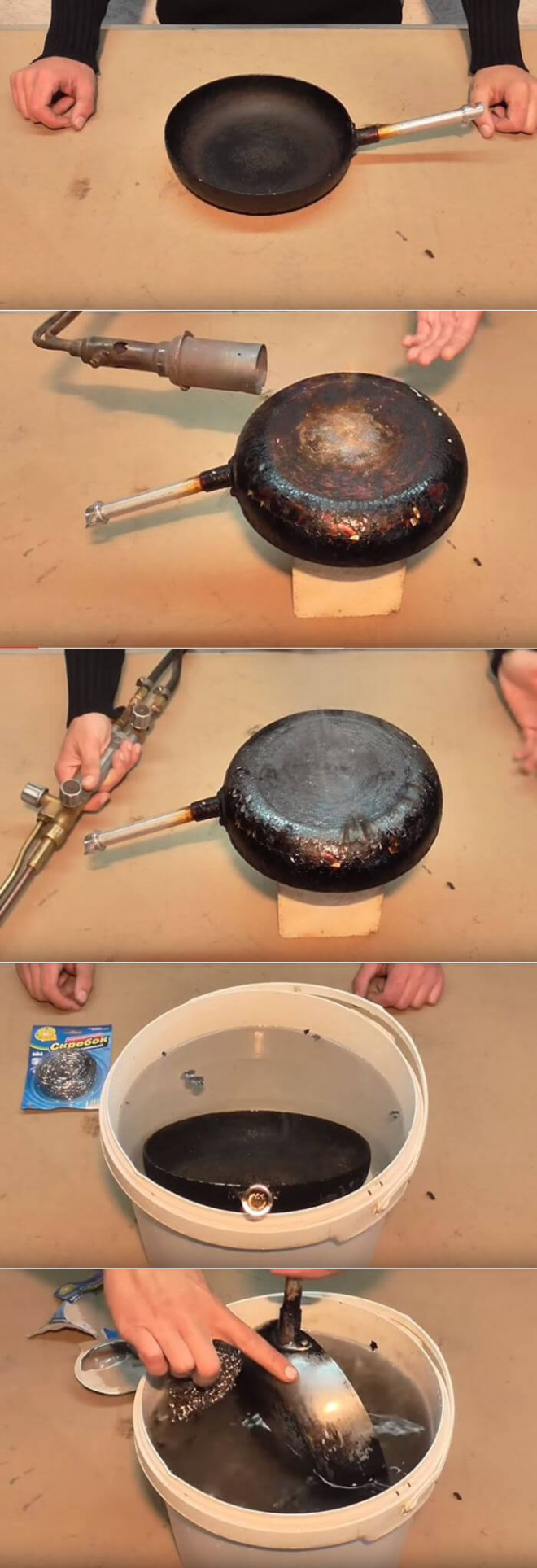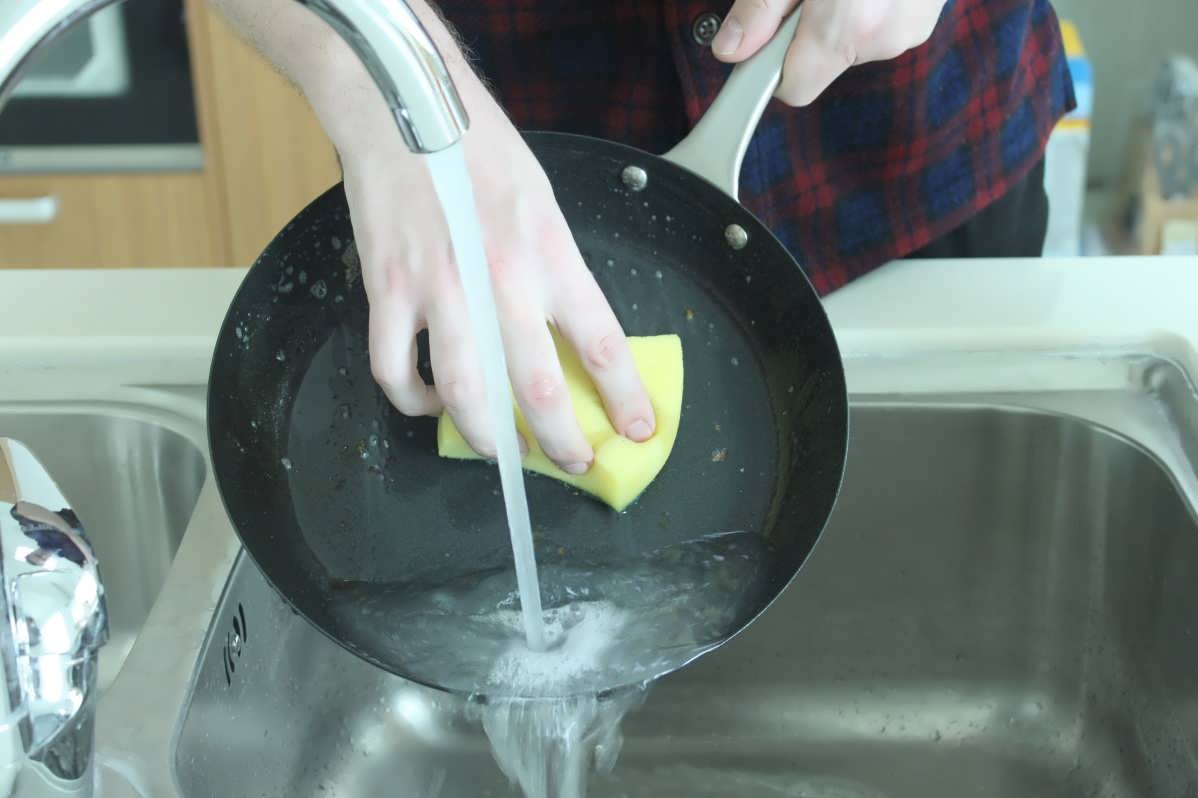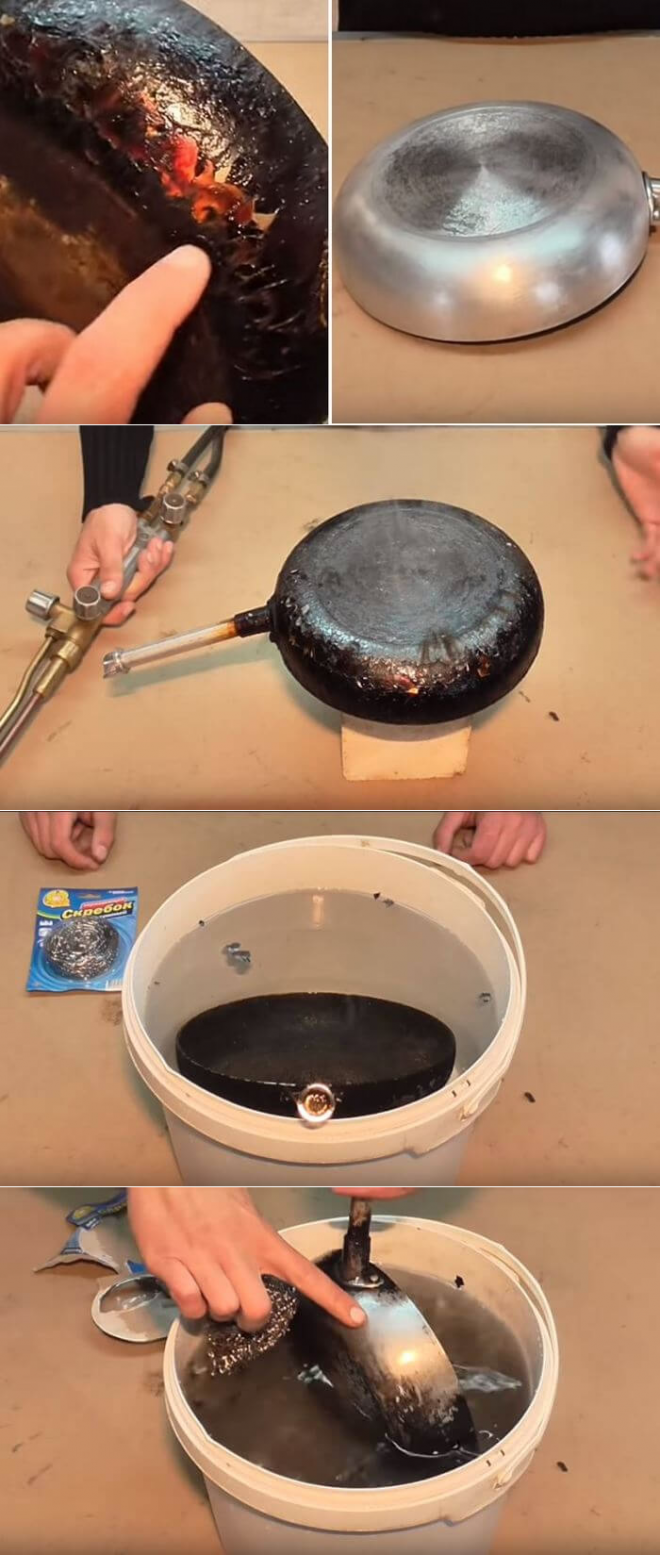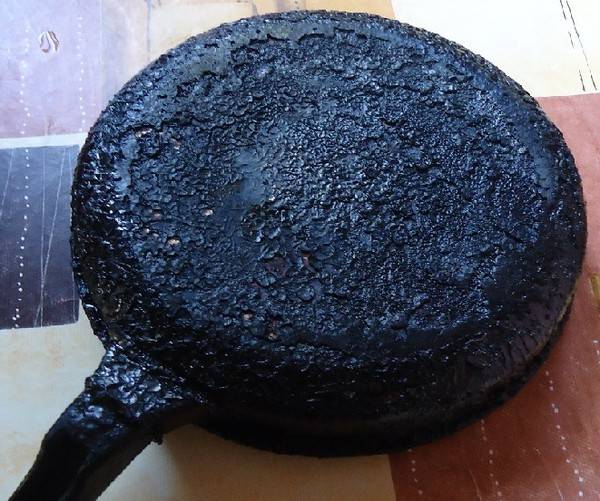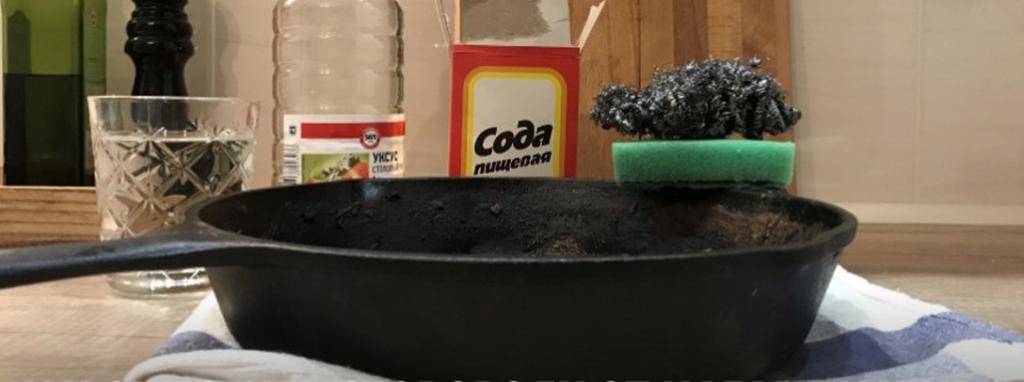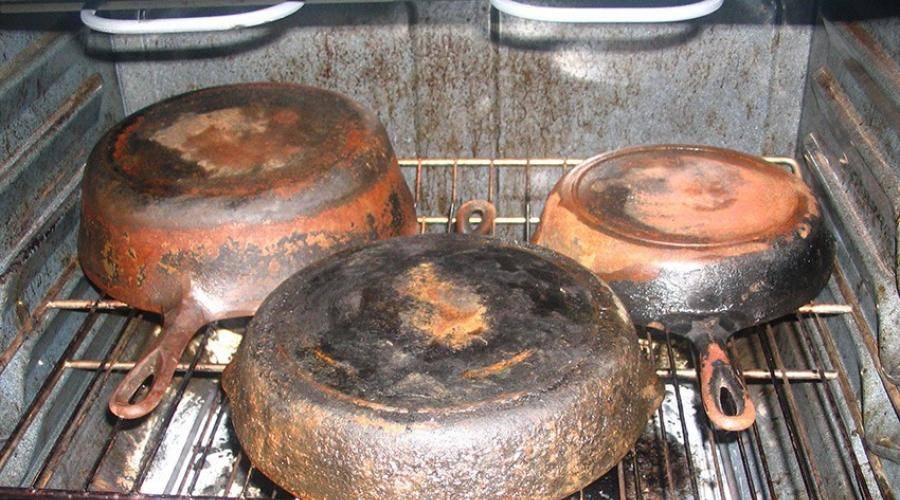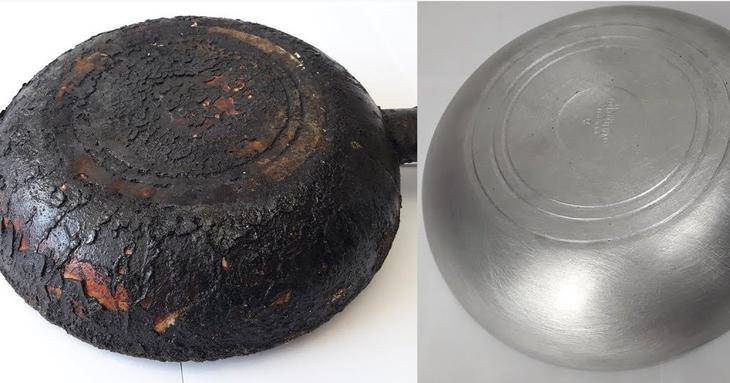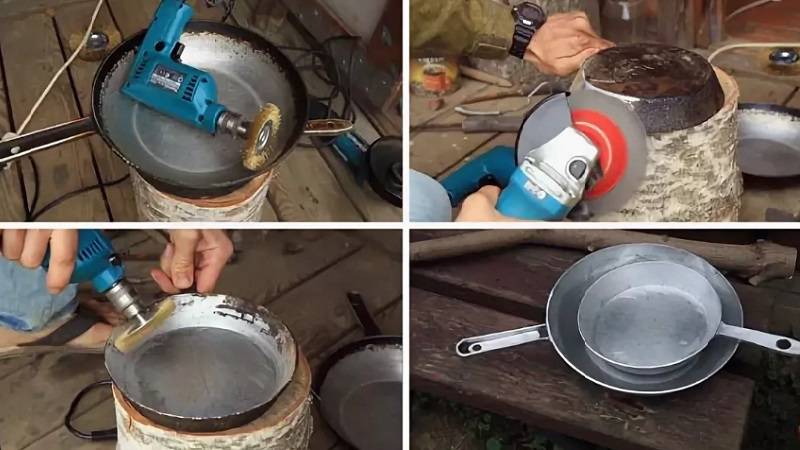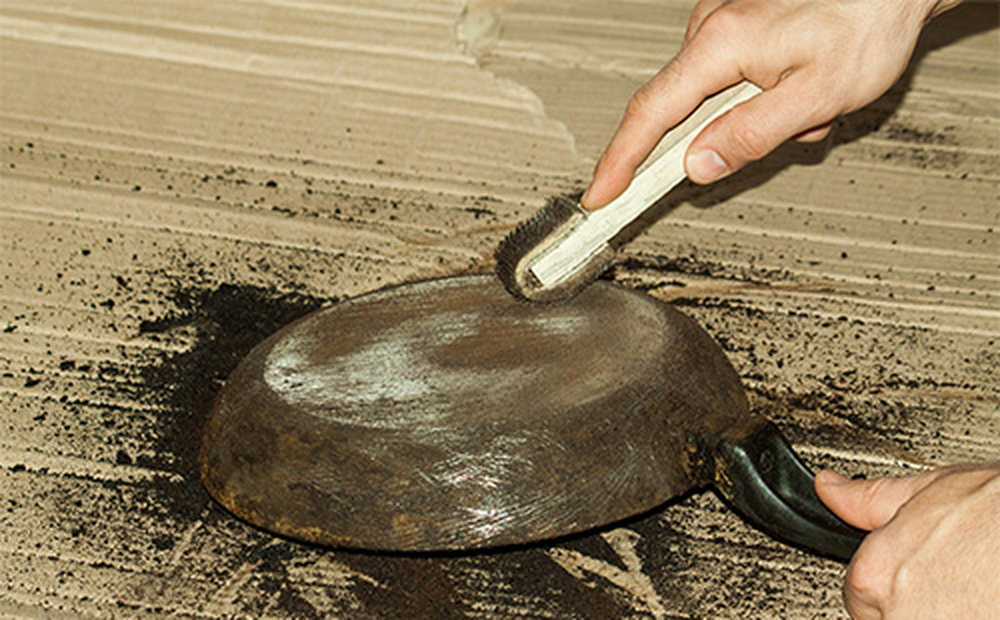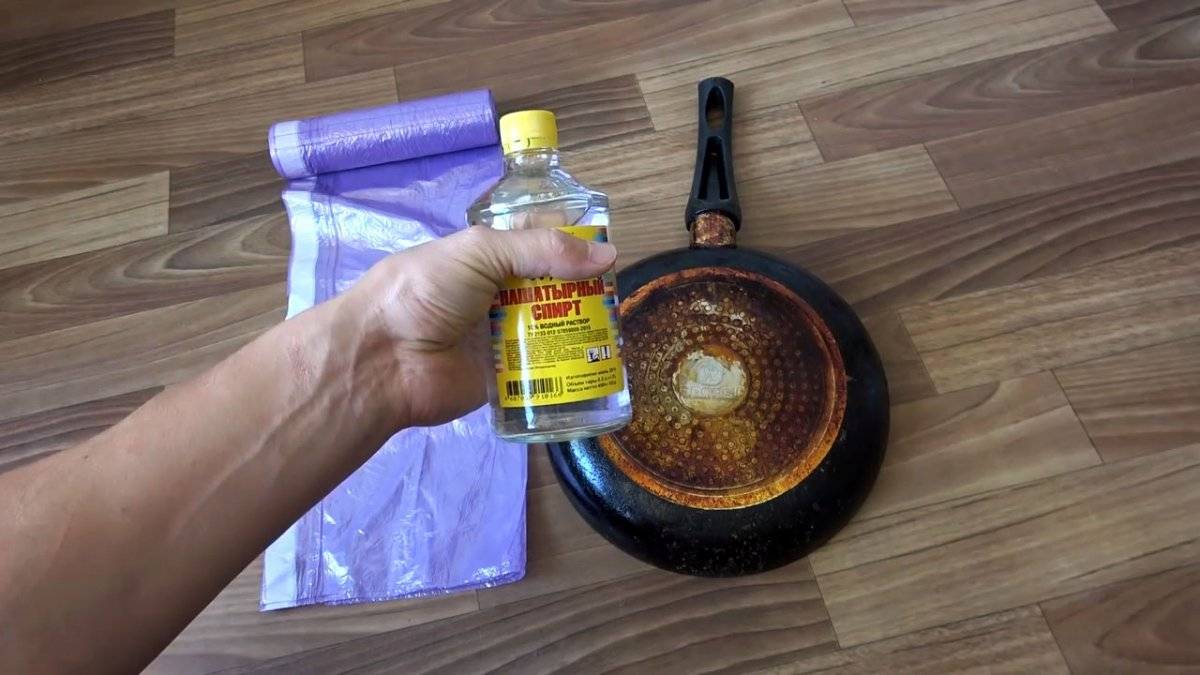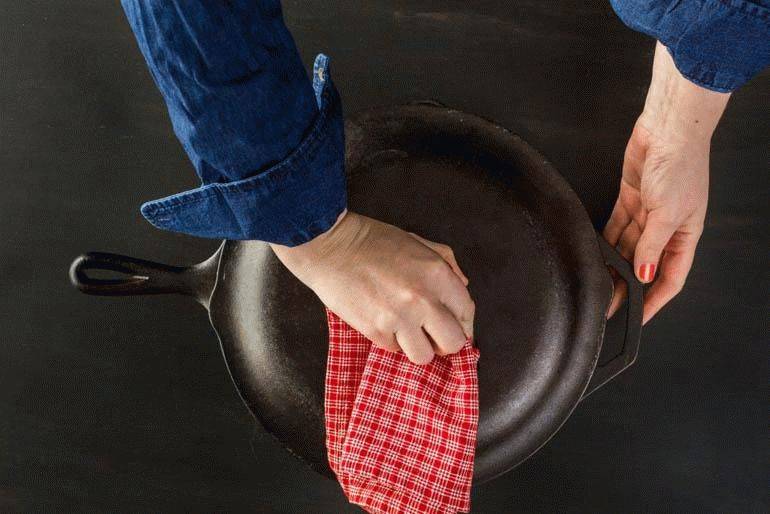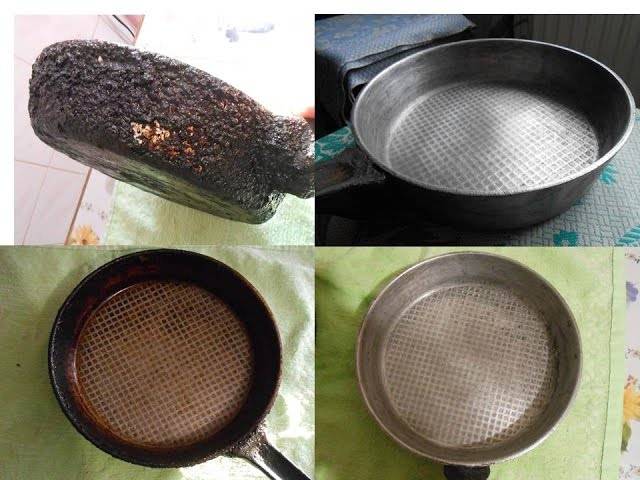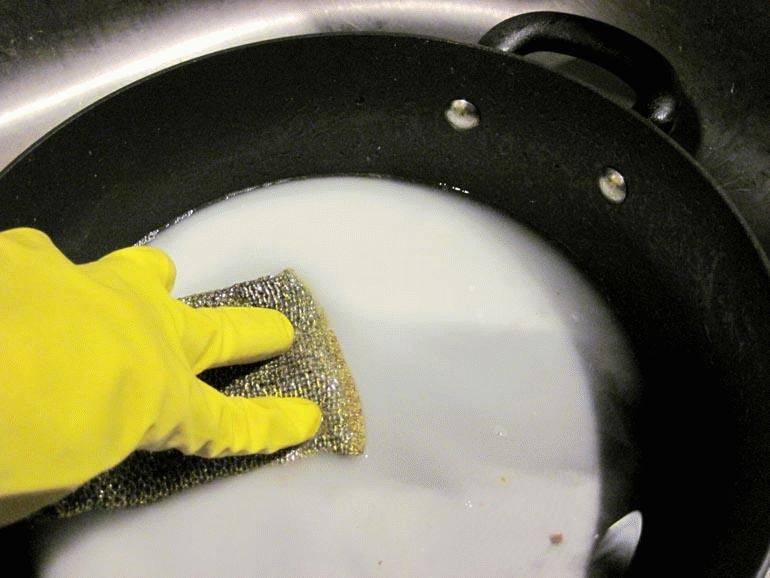How to clean different types of pans from old fat and carbon deposits at home
As mentioned earlier, a frying pan can be made of any material, each, however, requires its own approach. Do not clean a heavy cast iron pan in the same way as a Teflon pan. With these simple guidelines, it will be quite easy to clean all pans, no matter what they are made of.

A thick layer of burnt oil not only disfigures the appearance of the dishes, but also affects the quality of the food cooked in it.
Cast-iron pan
One of the most common varieties, which has a lot of useful qualities, but has a significant drawback: adhering carbon deposits are so firmly embedded in the porous structure of cast iron that it is quite problematic to wash it. But there is a solution to this. Since the cast iron coating is not sensitive to harsh influences, it can be cleaned with metal sponges, powders or sand. In car services there are special machines that can clean any dirt with sand and compressed air. An extravagant method for removing carbon deposits: put a pan on the fire. After some time, the carbon deposits will begin to come off in pieces. It remains only to rinse and dry with a towel.

Modern chemical cleaning preparations "anti-grease" effectively fight burnt fat.
Frying pan with enamel coating
Enamel is a thinner coating that does not tolerate harsh actions and caustic agents. You will have to use less methods to remove fumes and plaque. Folk remedies or the use of whiteness will be good
It is only important that the dishes are thoroughly rinsed after the procedure, because the ingress of detergents into the body is fraught with serious consequences. Better not to risk it

You can clean such dishes using both grandmother's methods and modern ones, but there are some limitations.
Aluminum frying pan
Aluminum is a light metal, and it makes dishes the same. You cannot rub the sides with an iron washcloth: ugly scratches will remain. A combination of mild detergents like toothpaste, baking soda, and soap works great. They will not spoil the appearance and rid the pan or pan of the greasy layer.

It is not recommended to wash aluminum utensils in the dishwasher.
How to clean burnt grease from a stainless skillet
Stainless steel was invented in order to make dishes from it that are not subject to corrosion. But she is not immune from the accumulation of oil and soot. Such a frying pan does not have features that would require a unique approach to cleaning. A strong saline solution, a mixture of soda and vinegar, and activated carbon are good for cleaning off carbon. It is better to wash with soft sponges, then rinse with running water and dry.

As a result of aggressive action, scratches are formed.
Removing old grease from a ceramic skillet
Burnt clay needs careful cleaning. It will be better if, after each cooking, the hostess wipes the cooled frying pan with a paper napkin that will absorb all the fat.
But if it turns out that the dishes are already heavily soiled, then there is nothing left but to use the “grandmother's” recipes. For example, boil water and baking soda. Soda also helps a lot. A bottle of cola or Pepsi is poured into the dishes and kept there for several hours. When the dirt is soaked, it is cleaned off with a sponge.
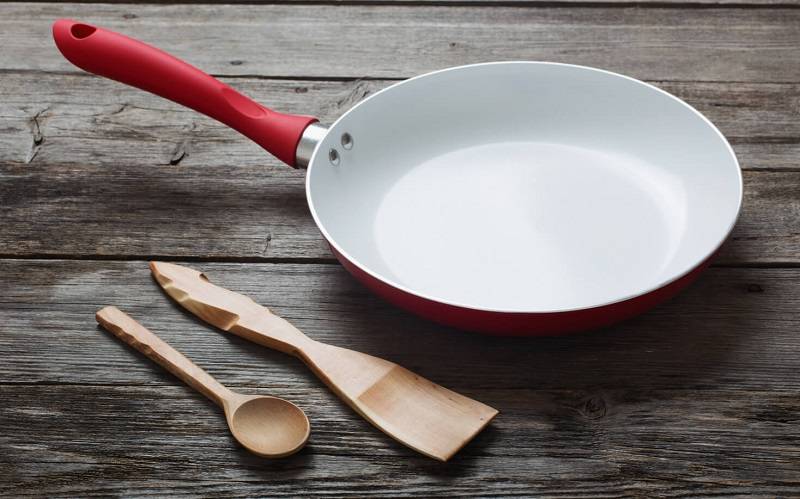
You can wash the pan and make it shine with a foam sponge and soapy water.
The nuances of cleaning teflon pans
Teflon is a very delicate coating that should never be scratched with forks or knives. Even coarse salt can leave deep marks behind. What to do?
Dried dirt can be poured over with slightly hot water and left to dry. After it is loosened with a spatula or sponge. Soda will work from detergents.
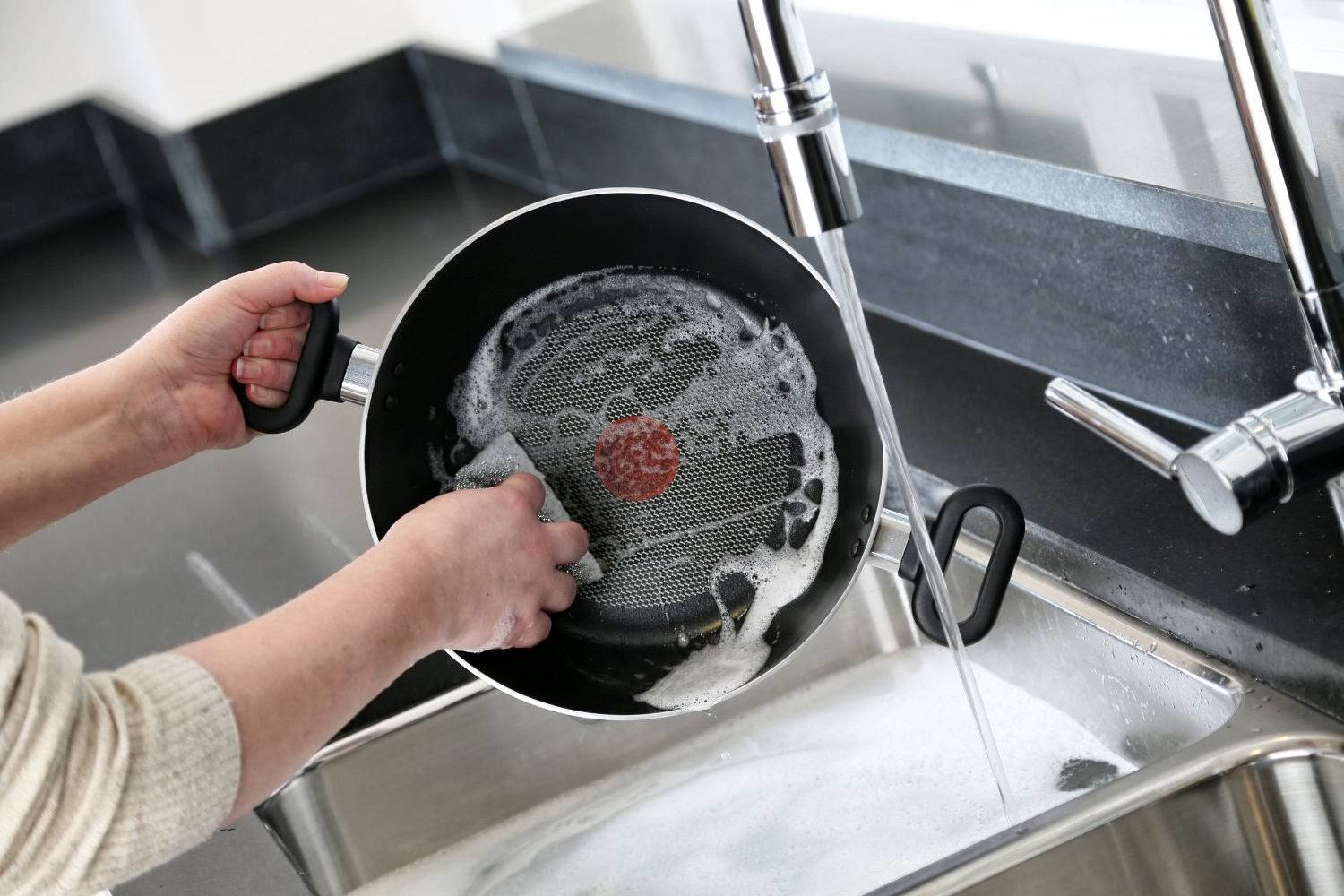
It is better not to put off washing such a pan until later, but to do it immediately after use.
Cleaning of cast iron products
How to clean a cast iron skillet from carbon deposits? This type of metal is the easiest to clean from old grease. To do this, you can use the following methods:
Blowtorch.
For this work, you will have to ask a man for help. The flame of the blowtorch is directed to the surface of the cookware, and carbon deposits will begin to fall off the surface on its own. The main thing is to remember that carrying out such work requires an open space (preferably on the street), away from the house or animals, in order to avoid a fire.
Bonfire.
The cast iron surface is perfectly cleaned under the influence of high temperatures. Outside, you can get rid of carbon deposits with a fire. It is enough to heat the pan over an open fire and remove the adhering formations with an emery or a knife. This method is ideal for pots or cauldrons that are made of cast iron.
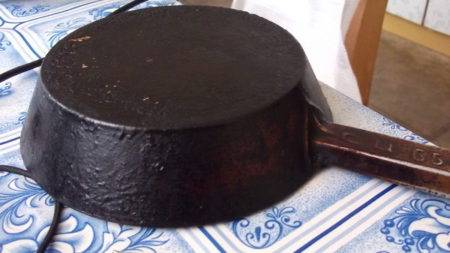
Sand.
In order to get rid of the burning inside, it is necessary to pour river or ordinary sand into the dishes and put on a slow fire. After a couple of hours, it is enough to pour out the sand and rinse the surface with clean water. This method helps to remove carbon deposits even without additional cleaning. The only safety measure: all work should be carried out in an open area, since the smell during heating the sand will not be pleasant.
Acetic water.
Vinegar is diluted with water in a ratio of 1: 3 and poured into the pan. The dishes are put on low heat and the mixture is brought to a boil. On low heat, the liquid should boil for about 3 hours, after which the surface will be perfectly clean. But this requires its own protection measures. During boiling, vinegar vapors will adversely affect a person's sense of smell, so the hood must work and the window must be open. If safety rules are ignored, a person can lose their scent for a long time.
Activated carbon.
An easy and affordable method of surface cleaning is the use of activated carbon. It is enough to moisten the coating of the dishes and sprinkle it with crushed activated carbon tablets. After an hour, it must be cleaned with any detergent.
Digestion.
This method will ideally clean not only pans, but also any kind of pot. To prepare the composition for digestion, take 1 bar of washing soap (brown), 1 small bottle of silicate glue, 200 g of soda ash. All this is added to a pot of water and brought to a boil. Then a frying pan or any other utensil is placed in this liquid and boiled for 30 minutes. This method can be used to wash off any dirt that forms on the surface.
Also, fat is quickly removed from the surface when digested in a solution from water and citric acid. For this, 1 tbsp is taken per liter of water. l. acid, and the dishes are digested within 15 minutes. After that, the carbon deposits are either removed from the surface with a cleaning sponge or gently scraped off.
Mechanical cleaning with a drill and an iron brush.
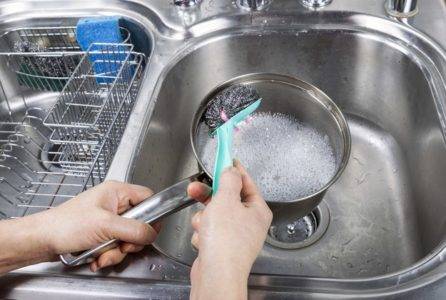
What are the most effective remedies for long-term carbon deposits
When the first stage is completed and the type of pan is indicated, you should choose the cleaning method that will be used. You have to choose a cleaning agent (folk, special method or using household chemicals), the degree of hardness of the sponge and even the method of cleaning (heating, soaking, boiling).
Now there are many methods that help remove old carbon deposits at home, but you should always choose not only on the basis of efficiency, but also safety. The composition must meet safety requirements not only for coating, but also for health.When cleaning pans inside, preference should be given to natural compounds, household chemicals, and use special gels exclusively for surfaces that do not have direct contact with food.
A list of effective and fairly universal methods is offered for review that meet all the declared indicators and help clean even heavily soiled pans.
Boiling with vinegar and soda
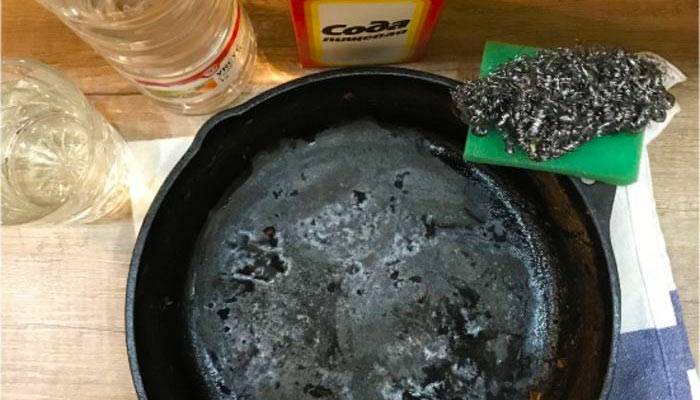
- An effective method that allows you to quickly clean the pan of contamination without much effort.
- A method that can be called universal in relation to the type of pollution. It will allow you to remove both carbon deposits with soot and stubborn, old fat.
- Although friction is not required, the method cannot be applied to non-stick pans. The combination of soda and vinegar, in combination with temperature exposure, can break down not only old burning, but also unstable Teflon spraying.
Boiling in soda solution
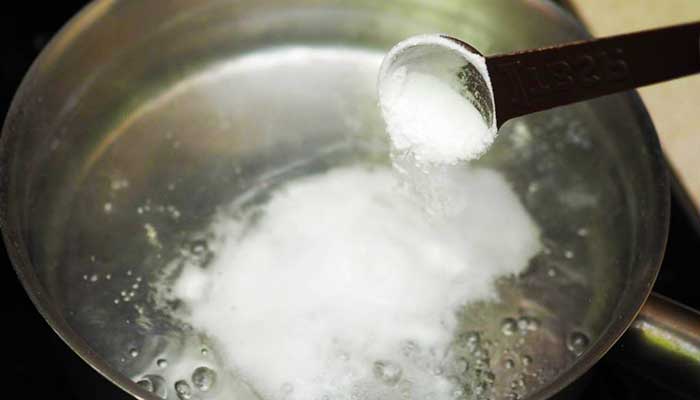
- A fairly quick method that allows you to simultaneously wash the pan, both inside and out, without any extra effort.
- The method is universal and suitable for all types of coatings and compositions, except for aluminum pans that do not have non-stick spraying.
Boiling according to the Soviet recipe
- Available, safe and unexpected substances are used that, when combined, give a magical result.
- Suitable for cleaning old carbon deposits from the outer part of dishes made of cast iron, aluminum.
Other methods
Softening / dissolving old carbon deposits with activated carbon:
- the method will not have an effect on complex contaminants that are characteristic of cast iron, however, it is very effective when cleaning ceramic and Teflon dishes;
- the uniqueness of the method lies in the fact that activated carbon actively breaks down, softens grease, dirt and soot.
Powerful chemicals specially formulated to remove stubborn deposits and grease:
allow you to wash pans without unnecessary effort;
it is important to follow safety measures and strictly follow the instructions from the manufacturers.
And in the end, we will designate the method that is most effective for cast iron pans, but, unfortunately, is an unacceptable luxury for others. This is nothing more than incandescence. The method allows you to clean the inside of the pan from years of burning deposits without the use of effort. It is enough to turn on the blowtorch and ignite the pan for a few minutes. Believe it or not, even old soot and fat will peel off from the walls of the dishes on their own.
Cleaning inside
Getting rid of carbon deposits from the inside is quite simple, because the inner one is often cleared immediately after cooking. But there are a number of limitations. Do not use powdered cleaners or metal sponges. Abrasive particles destroy the coating.
Do not use powdered cleaners or metal sponges.
The best way to clean small soiling is by boiling water in a bowl with a foamy detergent. It is enough to add a couple of drops to water, put on low heat and wait until boiling. Disconnect and let cool for an hour, just drain the water with burnt food particles. After that, it remains only to rinse with warm water.
The method is not suitable if the fat is old - it cannot be easily dissolved. Vinegar leads home remedies for caustic properties. It is often used for descaling teapots. You can do the same with a non-stick coating. Add a few drops of vinegar to the water, then boil it and repeat if necessary.
Be sure to thoroughly rinse the pan after each method to prevent chemicals from entering the body when cooking.
Laundry soap
There is a similar soap in every home, or you can buy it at your nearest store. The bar is inexpensive, but it will last for a long time.The composition of the soap contains caustic components that help to soften the resulting carbon deposits.
The composition of the soap contains caustic components that help to soften the resulting carbon deposits.
Step-by-step instruction:
- Grate the soap on a medium grater (the amount is determined by the degree of contamination, rarely more than a quarter is required);
- Spread the shavings evenly into the pan;
- Pour a small amount of water so that it covers the shavings;
- Heat the mixture, but do not bring it to a boil.
The alkalis in the soap will begin to dissolve food debris and carbon deposits without damaging the coating. It is recommended to leave the dishes soaked for 2-3 hours. Then thoroughly rinse off the soapy gruel and wash the pan.
Boiling with soda
Boiling with baking soda is a versatile way to clean both sides. A comprehensive method will require a larger bowl than a skillet. Then it just needs to be immersed in water with soda and boiled for an hour.
Boiling with baking soda is a versatile way to clean both sides.
Cleaning from the inside differs little from the method of boiling. You need to add 100 grams of baking soda per liter of water. Boil the mixture and let it cool, then wash the pan thoroughly. This is the best way to remove carbon deposits.
Note. A little secret to soften old soot and fat is to increase the boiling time to 2 hours
Soda + dishwashing liquid
Medium to light stains can be easily removed with a mixture of baking soda and dishwashing detergent. Pour hot water, add a teaspoon of baking soda and squeeze out a few drops of washing liquid. Place with a spatula, then leave for several hours. Then you just have to wash it with a sponge and clean water.
Medium to light stains can be easily removed with a mixture of baking soda and dishwashing detergent.
A more difficult and gentle way: make a paste from foam, baking soda and warm water. Pour baking soda with a slide, add detergent there and add a small amount of water. The mixture should resemble a thick paste. Put the paste on grease or soot for a few hours. Rinse with warm water. All carbon deposits will soften and be easily removed with a sponge.
Soda + stationery glue
An old method that works in hopeless cases. You will need to take to prepare the mixture:
- A suitable container for a frying pan to fit into. It is recommended to choose a deep metal basin.
- Laundry soap bar (rub one fourth).
- 0.5 cups of silicate glue (simple school glue, but not PVA!).
- 0.5 cups of baking soda.
Pour water into a basin, bring it to a boil. After that, pour soap shavings there, place them and only then add everything else. Stir the resulting solution until a homogeneous mass is obtained.
The smell of the mixture negatively affects the person, causing dizziness and hallucinations. It is necessary to turn on the hood at full power, or open a window for ventilation. The smell of the mixture negatively affects the person, causing dizziness and hallucinations (due to the glue).
Dip the pan into the mixture and cook for 2-4 hours, depending on how dirty it is. Some of the carbon deposits will fall off, the rest will become softer and can be washed off.
How to clean a pot of carbon deposits at home
Many years ago, pots existed, but there was no assortment of cleaning products. Maybe that's why many people got the dishes of our grandmothers - cleaning the pots at home was a common thing. Before you wash a smoked pan, you need to know exactly its material. For example, enamel will not tolerate mechanical cleaning with a rough and hard brush, and will immediately lose its appearance.
Everything you need for an aluminum smoked pan is always at hand - soda, vinegar, tooth powder, citric acid.
Aluminum
It doesn't take a lot of time and complicated tools to learn how to clean an aluminum pot.Everything you need for an aluminum smoked pan is always at hand - soda, vinegar, tooth powder, citric acid. Before using salt and vinegar to clean pots, you need to know the features of cleaning aluminum dishes:
- You can start washing only when the dishes have completely cooled down;
- You can not use anything that can damage the walls or the bottom of the dishes with a scratch - for example, you cannot clean the burnt with a knife;
- After you managed to clean the soot from the pan, the dishes must be wiped dry.
It is most of all that "likes" to leave a burn on itself, so after each use it must be thoroughly washed.
The main recommendations on how to clean an aluminum pot are as follows:
- Acidic products such as vinegar can be used in cases where the carbon is not too dense or there are simply greasy spots. You need to pour cold water, add 8 tbsp. tablespoons of vinegar and send everything to the stove. After boiling, the liquid should boil for about an hour more - and there will be no trace of carbon deposits. If there are problems on the walls, you can use the same method, but place the pan in a container with water and vinegar;
- Baking soda will wash away old carbon deposits or stale fat. Pour water into the dishes and add 1/3 of a pack of baking soda, then put on fire and boil for an hour;
- Citric acid will help to cope with the stuck porridge - fill the dishes with water, add 2 teaspoons of citric acid and let the solution boil for 1 hour.
 For stainless steel pots, it is not recommended to use hard brushes and aggressive chemicals.
For stainless steel pots, it is not recommended to use hard brushes and aggressive chemicals.
Stainless steel
It is believed that stainless steel cookware is incredibly durable. But the surface of such pans is delicate and sensitive, so harsh substances (abrasives and brushes) and aggressive chemicals (ammonia and chlorine) must be put aside. There are many ways to clean stainless steel pots at home:
- Grate with laundry soap, pour water into the dishes, add soap shavings and cook for 15 minutes. If boiling soapy water does not help, you can connect baking soda;
- With how to clean the pan from carbon deposits at home, ordinary activated carbon will help. You need to purchase a lot of tablets in advance, grind them into a cup, add warm water so that the consistency of sour cream is obtained. Spread the mixture on the affected areas and leave for 25 minutes;
- Baking soda can also clean up burnt food residues. Pour water into the dishes and add soda, in a ratio of 1 spoon to 1 liter of water, let the mixture boil for 10 minutes.
Before looking for options on how to quickly clean the pan from carbon deposits, you need to evaluate the material of the dishes and the degree of contamination. Thinner layers are best cleaned in gentle ways.
 Cookware with a damaged enamel layer will damage the food.
Cookware with a damaged enamel layer will damage the food.
Enamelled
By itself, such dishes have an enamel layer that is extremely easy to damage. Damaged enamel will damage the food and make it look unkempt. Therefore, the ways how to remove carbon deposits are especially delicate:
- A can of PVA glue boiled in a saucepan along with 0.5 pack of soda is one of the ways. Special conditions - to ventilate the house well during the procedure, and do not pour the solution into the pipe, it is better to do it outside;
- Plain salt sprinkled on the bottom of the burnt areas will also help remove the soot. The bottom sprinkled with salt should be filled with water and the brine should be boiled. This method will not work if you need advice on how to remove carbon deposits from an enamel pot inside - with the help of salt, you can only wash off new and weak formations. More stubborn stains will not be washed off by the salt.
Even with routine washing, metal sponges should be avoided in order not to damage the coating.
 It is not recommended to use metal sponges when washing enamel pots.
It is not recommended to use metal sponges when washing enamel pots.
How to clean a burnt frying pan outside
So, you need to solve a more difficult task - how to clean a frying pan with a non-stick coating from the inside and outside. Removing dirt from the outside can be much more difficult.One of the most effective methods is using baking soda and vinegar. Grate - outside! - a frying pan with soda and pour plenty of vinegar. After the hissing has ended, rinse with a sponge under a pressure of water.

It is important not to use detergents on the inner surface so that the chemicals do not penetrate the food, and then into the human body. You can also try power cleaning using a stiff brush attached to a drill.
You can also try power cleaning using a stiff brush attached to a drill.
But the incandescence method is categorically not suitable, pans with a non-stick coating cannot be heated empty, this leads to deformation of both the pans and the coating.

Any non-stick cookware will not tolerate harsh cleaning and scouring powders.
You can also use natural coffee grounds as a scrub for cleaning small dirt on the outside of the pan. It cleans perfectly - but only on the outside, remember about its abrasive properties and do not use it to clean the coating.
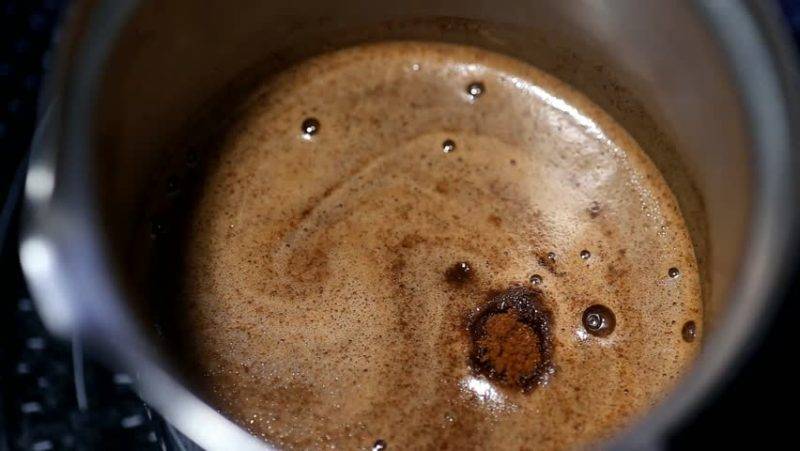
You don't even need to rub hard with a soft sponge to try to wash off the grease.
Note! Non-old and small stains can also be removed by boiling the dishes in regular Coca-Cola. This drink has already been repeatedly noticed for its cleaning properties - and it copes with pans as easily as with coins and rust.
Prevention measures
When it was possible to completely get rid of the remnants of fat or a thick layer on the surface of the pan, then it is necessary to take all preventive measures in order to prevent its reappearance in the future. To do this, you should follow a few simple rules:
- 1Clean the outside and inside immediately after cooking, before the dishes are completely cool.
- 2Do not wash the surfaces of the pans in the dishwasher all the time. Perform manual cleaning several times a week. This will allow you to notice the formation of burning in the initial stages and easily get rid of it.
- 3Before using a new frying pan, it should be lightly treated with sunflower oil and washed with detergent.
- 4 Minimize the use of powdered cleaners, iron sponges, or other abrasive materials at hand.
How to clean pans made of different materials, you learned above. The most important thing that every housewife needs to remember: do not allow a harmful and disgusting layer of soot to form on the dishes, which not only makes the dishes unattractive, but also harms the health of all family members.
Cleaning the product from carbon deposits outside
There are four effective home remedies for removing carbon deposits.

Digestion
To do this, you need to prepare the dishes in which the pan will be boiled. It must fit entirely into this container. Next, it must be filled with cold water and placed on the stove, turning on a large flame. After the liquid boils, you need to grind the laundry soap with a coarse grater and throw it into boiling water. You should also add 0.5 cups of baking soda and silicate glue to the pan. After preparing the solution, you need to lower the pan into it. If the handle is unscrewed on it, it must be removed. Boil the product over low heat. The digestion time depends on the level of contamination.
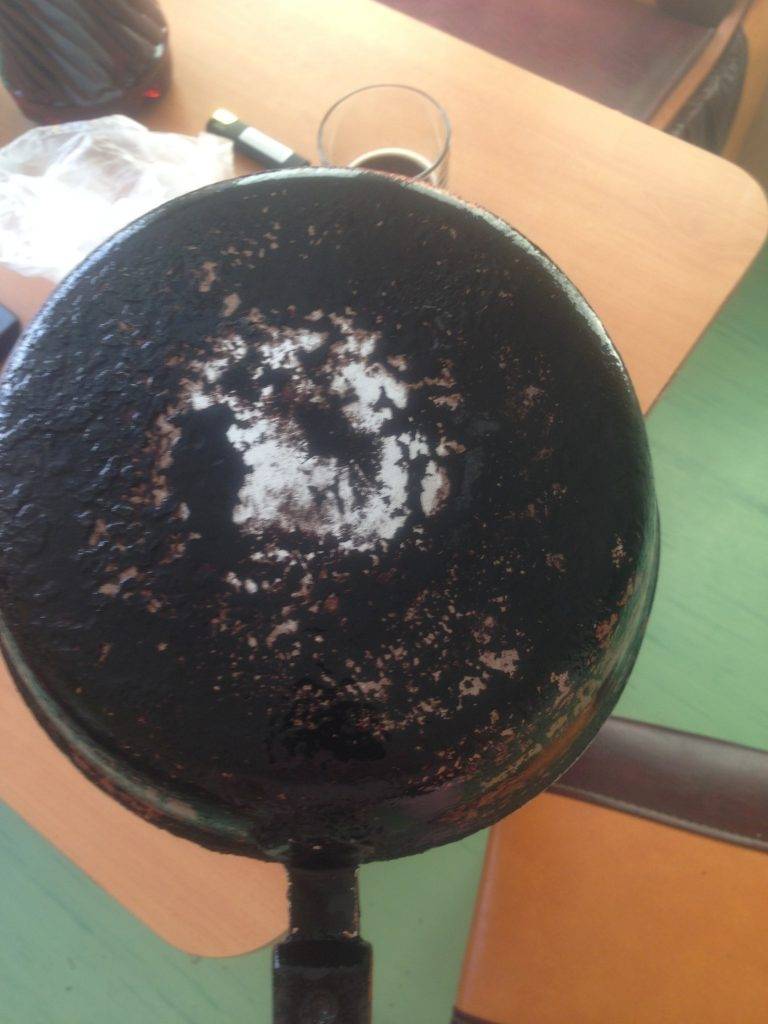
Vinegar solution
To prepare the solution, it is necessary to dilute vinegar, salt and soda in water. It must be poured into the dishes and put on the stove, turning on medium heat. After the liquid boils, the entire product must be rinsed with this composition. You will need to use a brush to clean the outside edges of the pan. It should have stiff bristles. After completing the process, the product must be thoroughly washed with water.

Activated carbon
This pharmaceutical preparation is needed to remove burning from the outside of the product. It takes about 10 tablets. Their number depends on the size of the dishes.They must be crushed and sprinkled with powder on a moistened surface. After 30 minutes, the pan should be washed using a special product and a brush.

Citric acid
It will also help remove carbon deposits from the outside. It must be diluted in water (1 l). This liquid must be poured into a suitable container and boiled. Then you need to dip the product into it. After the water has cooled completely, the dishes are removed and cleaned with a stiff brush. Before embarking on the cleansing process, you should take care of safety. After cleaning the frying pan often occurs with the use of chemical compounds.

Therefore, during the removal of dirt, the following rules must be followed:
- perform all actions with rubber gloves. Today, models with different rubber thicknesses are on sale;
- be sure to protect your face with a respirator;
- perform all work in a well-ventilated area;
- remove children and pets from the kitchen if possible.

By following these rules, it will be possible not only to rid the pan of the burning layer, but also to protect the hands and respiratory organs.

